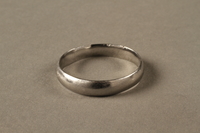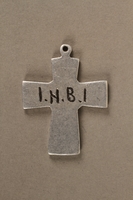- Description
- The Gisela Laufer Wortman, William Laufer, and Naum Wortman papers consist of biographical materials, correspondence files, displaced persons camp records, photographs, and printed materials documenting Dr. Gisela Laufer Wortman, her first husband Dr. William Laufer, and her second husband Dr. Naum Wortman. The Dr. Gisela Laufer Wortman papers document her family from Tarnobrzeg, Poland, their deportation to the Soviet Union during World War II, and her wartime and postwar
medical training in Ashgabat, Prague, and Vienna. The Dr. William Laufer papers trace the Laufer and Rubinstein family’s refuge in Lvov and deportation to a labor camp in Marijska (Mari El, Russia). The Dr. Naum Wortman papers document Wortman’s work as a doctor at the Auschwitz concentration camp and the Ebensee and Ebelsberg displaced persons camps as well as his first wife Gisela Plancer Wortman’s description of the Kraków-Płaszów concentration camp.
The Dr. Gisela Laufer Wortman papers include biographical materials and photographs documenting her family from Tarnobrzeg, Poland, their deportation to the Soviet Union during World War II, and her wartime and postwar medical training in Ashgabat, Prague, and Vienna.
The Dr. William Laufer papers include reproductions of identification papers for Masha Rubinstein, Josef Laufer, and Teofila Laufer; Laufer and Rheinhold family correspondence; forms completed by Robert Zelman Rubins related to the International Commission on Holocaust Era Insurance Claims; and two documents regarding Dr. William Laufer’s medical credentials. Laufer and Rheinhold family correspondence consists of a single folder of correspondence dated 1940-1941 among William Laufer, his father Melech Rubinstein, his brother Josef Laufer, and the Reinhold family in Krakow. The correspondence traces the Laufer and Rubinstein family’s refuge in Lvov and deportation to a labor camp in Marijska, an autonomous Soviet Socialist Republic now known as the Mari El, Russia.
The Dr. Naum Wortman papers consist of biographical materials, correspondence files, displaced persons camp records, photographs, and printed materials documenting Wortman’s family; his work as a doctor at Auschwitz and for the United Nations Relief and Rehabilitation Administration, American Joint Distribution Committee, and International Refugee Organization at Ebensee and Ebelsberg; and his immigration to the United States. The collection also includes a description of the Kraków-Płaszów concentration camp by Wortman’s first wife, Gisela Plancer Wortman.
Biographical materials include correspondence, forms, identification papers, and a marriage certificate documenting Naum Wortman’s stays at the Ebensee and Ebelsberg displaced persons camps, his marriage to Gisela Plancer, and his immigration to the United States. This series also includes records documenting Wortman’s medical training, experience, and efforts to reestablish his career after the war, his 1969 deposition about conditions at Auschwitz, and a working drawing for a bronze memorial plaque for his family. This series further includes a description of a scene at Kraków-Płaszów concentration camp by Naum Wortman’s first wife, Gisela Plancer Wortman, a certificate documenting her qualifications as a dental technician, and records documenting her 1949 immigration to the United States.
Correspondence files primarily consist of postwar letters and postcards among Naum Wortman, his extended family, and friends from his pre-war life or whom he met in the displaced persons camps later living in America, Argentina, Austria, Canada, France, Germany, Italy, and Palestine. The messages describe wartime experience, postwar life, and plans for emigration. Later correspondence includes Wortman’s letter to the editor on the subject of the atom bomb as well as correspondence with Gisela Wortman memorializing Naum Wortman.
Displaced persons camp records include authorization and identification forms, letters of recommendation, autobiographical statements, and correspondence regarding the business of the camps, particularly in relation to medical care. These materials also include notebooks in which Wortman registered births and recorded surgeries performed in the camps, and envelopes, forms, and letterhead relating to Wortman and to the American Joint Distribution Committee.
Photographs include images of survivors and camp conditions at the Ebensee concentration camp shortly after liberation and Naum Wortman and his family.
Printed materials include a 1945 issue of Die Mitteilungen announcing Germany’s capitulation, a 1946 issue of the Ebensee publication Nazi-Opfer: Monatszeitschrift ehemaliger politischer Häftlinge, 1959 clippings about Dr. Wortman’s medical career in Far Rockaway, and a 1966 issue of Hadassah Magazine including an article about Auschwitz.
- Date
-
inclusive:
circa 1914-2004
- Credit Line
- United States Holocaust Memorial Museum Collection, Gift of Gisela Laufer Wortman
United States Holocaust Memorial Museum Collection, Gift of Albert Laufer
- Collection Creator
- Gisela L. Wortman
William Laufer
Naum Wortman
- Biography
-
Dr. Gisela Laufer Wortman (1923-2013) was born Gisela (“Giza”) Nussbaum in Tarnobrzeg, Poland to merchant Jozef Pinchas Nussbaum and Frymeta Liba Zeisel Nussbaum. She had two brothers, Nissan (1915-1992) and Hersh “Zvi” (1919-1966), and a sister, Sara “Sonia” (Symchowicz, 1928-2017). In mid - September 1939 the German Army reached Tarnobrzeg, and the Jews were marched towards Radomyśl nad Sanem and expelled into Soviet-occupied Poland. The Nussbaum family arrived in Lvov, and in June 1940 the family was arrested by the NKVD and deported to a forced labor camp in the far north of Russia. In the fall of 1941, after the German invasion of USSR and the amnesty for the Polish prisoners in the Soviet forced labor camps, the Nussbaum family was released and relocated to Uzbekistan. During the war, Gisela pursued medical studies in Ashgabat, and in 1945 the Nussbaum family returned to Poland. Gisela finished university in Prague and later graduated from medical school in Vienna. She immigrated to the US and settled in New York City, where she completed her medical internship and residency. In 1951 she married Dr. William J. Laufer. After his death in 1966, she married Dr. Naum Wortman.
Dr. William J. Laufer (1912-1966) was born Wolf “Welek” Laufer Rubinstein, in Krakow, Poland to Meilech “Maks” Rubinstein and Chaja Gitl Laufer. He had a younger brother, Josef “Lolek” (1919-1941), and sister, Teofila “Tosia” (b. 1921), as well as a stepmother, and half-brother, Zalman “Zyga” (1923-2009). William attended medical school in Bologna, Italy and after graduation in 1938, he returned to Krakow. In September 1939 the family fled German occupied Poland to Lvov. All but Josef were deported from Lvov to Marijska, an autonomous Soviet Socialist Republic (today Mari El, Russia), where they were imprisoned in a forced labor camp. Josef perished following the German invasion of the USSR in 1941. Meilech Rubinstein died in 1943 in Turkmenistan. Dr. Laufer immigrated to New York City in 1950, where he completed his internship and residency in psychiatry. He married Dr. Gisela Nussbaum in 1951. They moved to Long Island, NY where they owned and directed a small psychiatric hospital. He and Gisela had two sons, Marcel and Albert. His stepmother’s Rheinhold family also survived the war.
Dr. Naum Wortman (1914-1988) was born in Chełm, Poland to Izak Wortman and Helen “Chaja” Wortman (nee Rozowykwiat) and raised in Warsaw. After the German invasion, Wortman fled to the Soviet sector of Poland, and worked as a physician in Szczucin under Soviet occupation and then German occupation. His parents and brother Jozef (1924-?) survived the Warsaw ghetto, and were deported to Treblinka where they perished. In November 1942, Dr. Wortman was deported to the concentration camp at Bogusze, Poland, and in January 1943 to Auschwitz-Birkenau, where he worked in the hospital barracks. When Auschwitz was evacuated in January 1945, he was sent on a forced march to Mauthausen and liberated at Ebensee. He continued to work as a physician in the displaced persons camps at Ebensee and Ebelsberg. He immigrated to the United States in March 1949 with his first wife, Gisela Plancer Wortman (1913-approximately 1960s) and settled in Far Rockaway, N.Y. After his wife’s death, he married Dr. Gisela Laufer Wortman in 1971.










